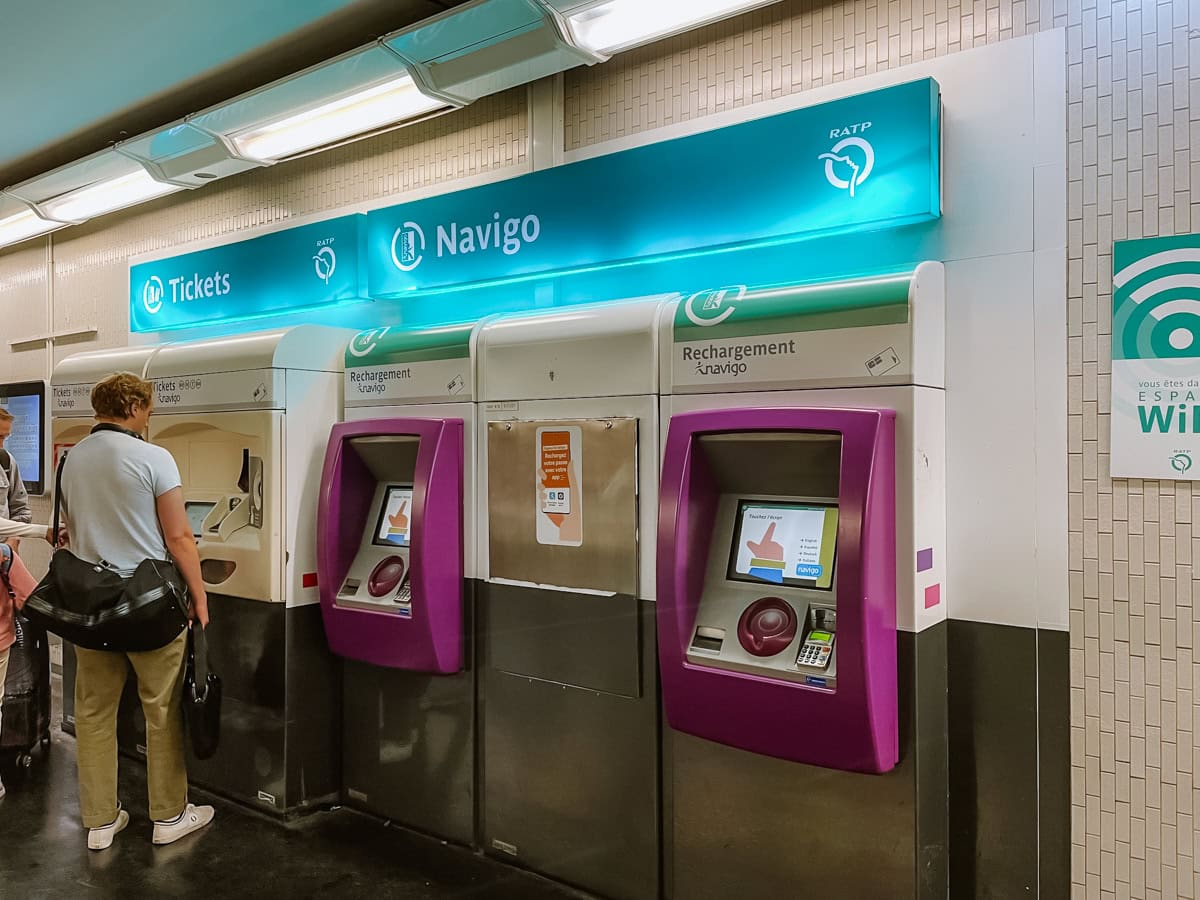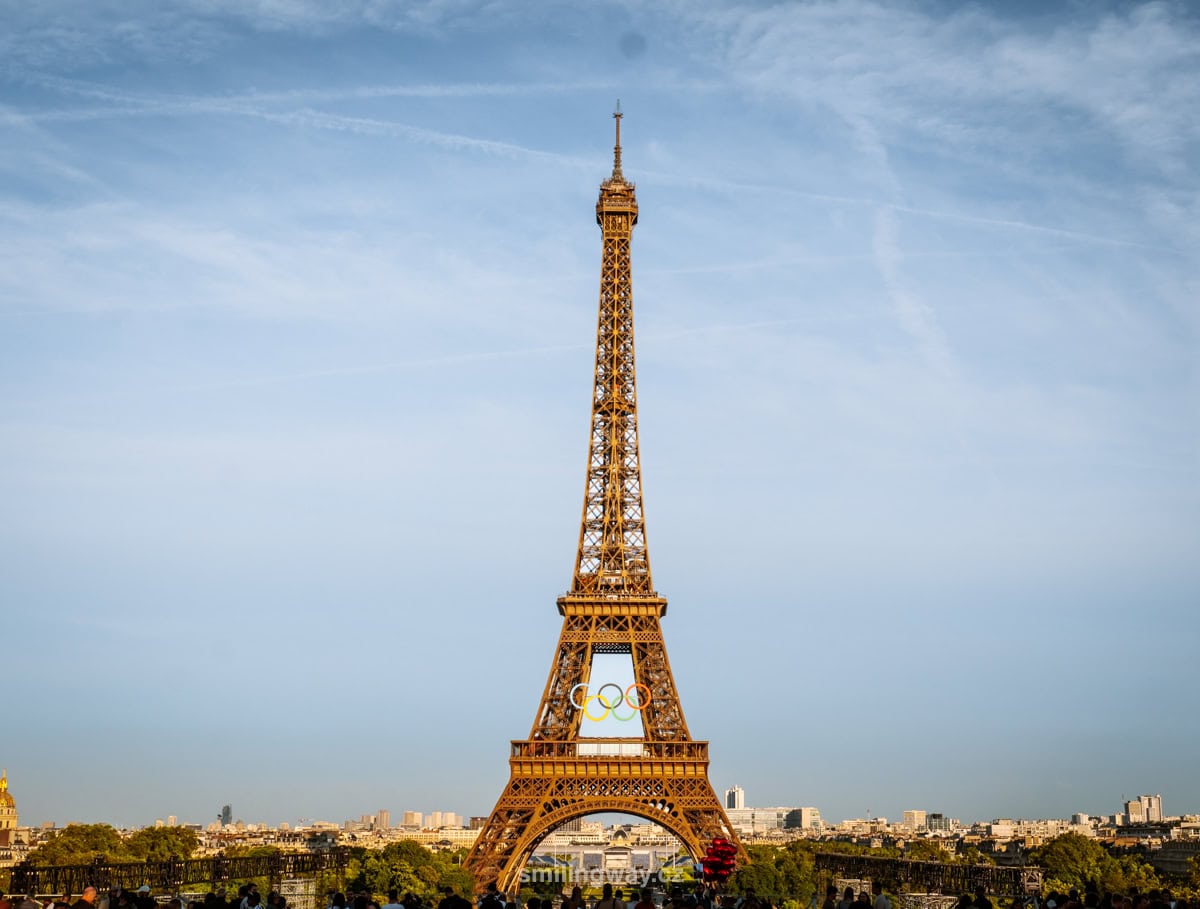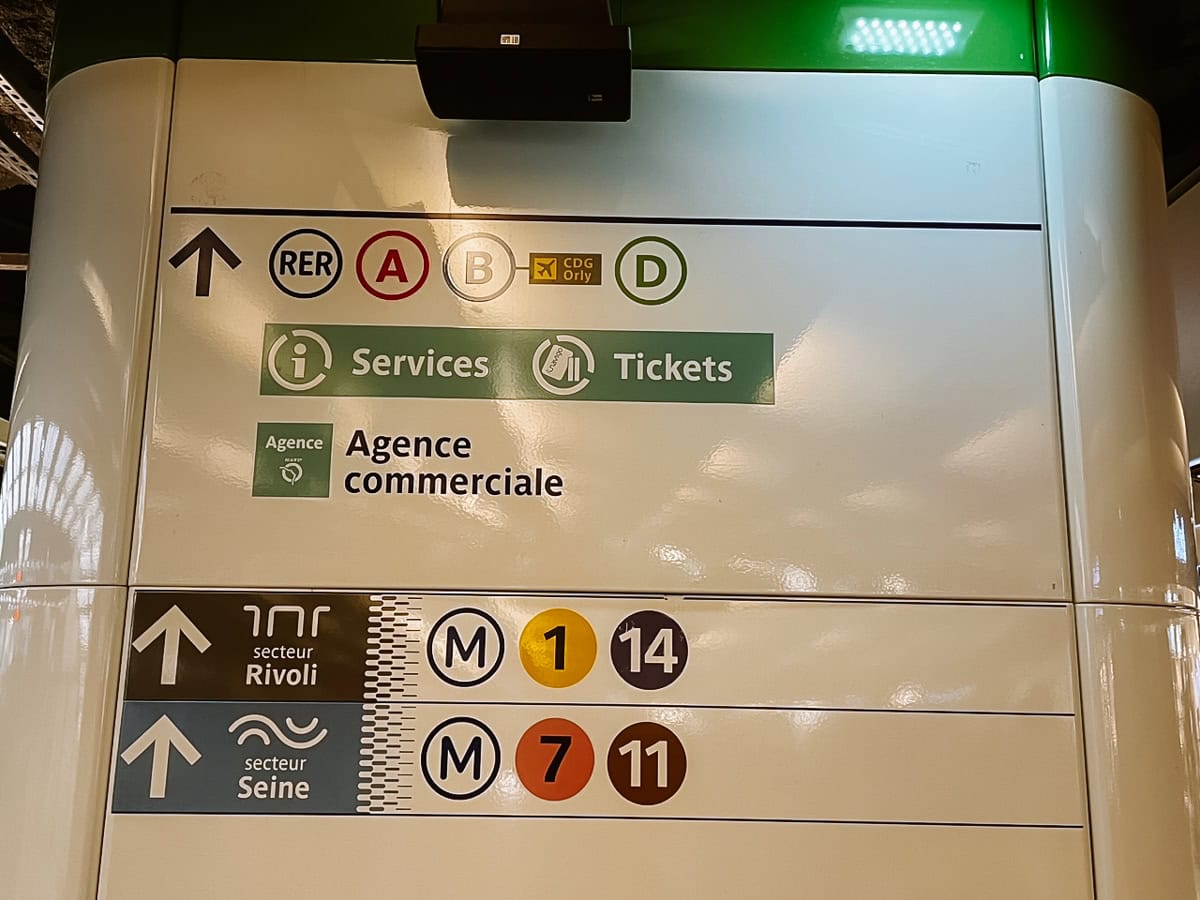Paris is the second most popular city in Europe after London. Almost all of us want to visit the city of lights and romance. How does the transport work here, how to get from the airport to the centre of Paris or how does the public transport and metro work in Paris? We’ll cover everything in today’s article.
Transport to Paris
Paris is very well connected to the rest of Europe and has a dense network of train and bus connections. It is also accessible by direct flights from most major European cities.
By bus and train to Paris
Travelling by bus is not one of the most popular ways to get to Paris. This is why the number of bus connections from European cities is limited.
Paris has direct bus connections to Prague, Munich, Salzburg and Amsterdam, for example.
The same applies to trains. Paris has a direct connection to Frankfurt (4 h; prices from €90).

By air to Paris
Paris has very good direct air links to many European cities including Prague, Berlin, Vienna, Krakow and Amsterdam. Return tickets on low-cost airlines start at €130. Occasionally there are promotions where you can get tickets even cheaper.
Paris airport
If you are flying to Paris, you will arrive at one of the following airports:
- Beauvais Airport (BVA)
- Charles de Gaulle Airport (CDG)
- Orly Airport (ORY)
Beauvais Airport is the furthest airport from Paris. It is mainly served by low-cost airlines such as Ryanair and Wizz Air. Although the fares to Beauvais Airport are tempting, you need to add on the journey to Paris.
We’ll show you how to get from the airport to the centre of Paris now.

How to get from Orly Airport to the centre of Paris?
Orly Airport is located 13 km south of Paris. There are several ways to get to the centre of Paris.
Tram T7
The cheapest way is on the T7 tram, where a ticket costs just €2.15. The tram can be reached from Terminal Sud (Terminal 4). You get off at Villejuif-Louis Aragon station, where you jump on the metro 7 (another ticket for €2.15) and from there you go straight to the centre. The journey time is 40 minutes. The tram runs every 8-15 minutes from 5:30 AM to 12:30 AM (05:30-00:30). It is part of the Paris Navigo Decouverte Pass.

Orlybus
The other, slightly easier but also more expensive option is the direct Orlybus for €11.50 (€10.30 with Navigo Easy), which takes you to Place Denfert-Rochereau to the Paris Catacombs in 30 minutes. From there, it’s easy to get where you need to go.
If you plan to take the metro to the centre, you will need to buy an additional ticket for €2.15.
Orlybus is part of the Paris Navigo Decouverte Pass. It stops in front of Terminal 4 and Terminal 2 (you can board at Terminal 2 if you are arriving at Terminal 1, 2 or 3). The Orlybus runs from 5:30 AM to 12:30 AM (05:30-00:30).

Orlyval
Another option is the special Orlyval metro line, which takes you to the RER B Antony station in a few minutes for €14.50, where you can catch the train. The price is valid for a combined Orlyval and RER B train ticket to the centre (you don’t need to buy a new ticket). The Orlyval line operates from 6:00 AM to 11:30 PM (06:00-23:30). Not included in the Paris Navigo Decouverte Pass.

Metro line 14
Metro line 14 will be extended to Orly Airport from 24 June 2024. The fare will be €11.50 and the journey time will be approximately 15-30 minutes depending on where you are travelling from. On the map you can find the stations through which the line will pass – the dotted parts will be in operation only during 2025.
More information: The airport’s official website has more information on how to get to Paris. Here you can enter where you are going from and where you are going to, and a detailed description of the route, including the price, will be shown.

How to get from Charles de Gaulle Airport to the centre of Paris?
Charles de Gaulle Airport can be found to the north-east, approximately 23 km from the centre. It is the second largest airport in Europe.
RER B
RER B trains are the easiest way to get from Charles de Gaulle Airport to central Paris. A one-way trip costs €11.80 and you’re in the centre in 25-45 minutes, depending on where you’re going. The train runs during the day with a frequency of 10-15 minutes.
RER B stops at CDG Airport at two stations – Aéroport Charles de Gaulle 1 for terminals 1 and 3 and Aéroport Charles de Gaulle 2 for terminals 2A, 2C, 2D, 2E, 2F, 2G.

RoissyBus
Also popular are the low-floor RoissyBus buses, priced at €16.60, which run non-stop on the way to Opéra station in the city centre. You can buy your ticket from the machines at the airport.

Buses 350 and 351
The last option are bus lines no. 350 and 351, where the fare is only €2.15. These buses stop along the way and run every 30 minutes. You can buy your ticket at the ticket machines at the airport.
You cannot use a t+ ticket to travel from the airport.
More information: Visit the airport’s official website for more information on how to get to Paris. At this link, you can enter where you’re coming from and where you’re going and it will show you a detailed description of the route, including the price.

How to get from Beauvais Airport to the centre of Paris?
Beauvais Airport is mainly operated by the low-cost airline Ryanair. The airport is located 83 km northwest of Paris.
A one-way trip by direct bus will cost you €16.90. The bus takes about 90 minutes and you get off at Porte Maillot, where you can almost see the Arc de Triomphe.
For more information, visit the official Beauvais Airport website for detailed information and to book tickets in advance.

By car to Paris
Paris has very good road connections to major European cities. What is the distance to Paris from selected locations in Europe?
- Prague – 10 h 35 min; 1 030 km
- Brno – 12 h 10 min; 1 235 km
- Berlin – 11 h 10 min; 1 060 km
- Munich – 9 h; 840 km
- Vienna – 12 h 40 min; 1 240 km
What are the speed limits in France? The speed limit is 50 km/h in villages, 90 km/h outside villages, 130 km/h on motorways and 110 km/h in rainy weather. On the circuits around Paris, driving is limited to 70 km/h. Don’t forget your green card and never drive in bus lanes.


Charges for travelling by car to Paris
In France, motorways are tolled. You can calculate the toll price at this link.
Petrol and diesel prices vary from country to country. The current fuel prices can be found at this link.
Parking in Paris
On-street parking in Paris is usually paid from Monday to Saturday between 9:00 AM and 8:00 PM (09:00-20:00). Parking is free on Sundays and at night. You can also park for free on selected streets on certain public holidays – the parking meters are marked with a yellow sticker. Free parking spaces are available near Bois de Vincennes and Bois de Boulogne.
There are 2 fare zones – in the centre and outside the centre. For an hour of parking in the city centre you will pay around €4-€5 and on the outskirts around €2-€3.
How do you pay for parking? You have 3 options:
- Paris card, which you can buy in any newsagent
- payment card
- PaybyPhone app
The parking ticket is then placed visibly behind the windscreen. Street parking is usually limited to 2 hours.
The other parking option in Paris is the underground garages, which are open 24 hours a day. Garages marked with a white “P” on a blue background are also for motorcycles. Security is provided by guards and cameras.
Hotels in Paris 😴

You’ll pay around €4-5 per hour for underground parking in the city centre and around €20 per 24 hours on average on the suburbs of Paris.
Please note: The centre of Paris is part of the ULEZ. You must purchase a Crit’Air sticker to enter the zone by car. Find out more here.
If you’re not planning to drive all the way to the centre of Paris, park on the outskirts of Paris – there are several dedicated Park and Ride car parks that are well connected to public transport in Paris.
Parking apps in Paris
Parking apps are the easiest way to pay for parking in Paris. You enter where you are (for example, the Eiffel Tower) and the app shows you parking within a radius of that location, including the number of spaces available and the price of parking. You can also reserve a parking space.
Public transport and metro in Paris
Use public transport in Paris to get anywhere. You can take the metro, trams, buses, but also RER trains that take you to the more distant parts of Paris and beyond (for example, Disneyland). For better orientation I attach a map of the transport in Paris: Map of public transport in Paris.
Metro in Paris
The most popular transport in Paris is the metro. There are 13 lines serving 303 stations in the city. Each line is distinguished by colour and number and is marked on platforms and stations. Here you can find a map of the metro in Paris.
To pass through the turnstiles, you can attach your Navigo Easy card to the reader or swipe your paper ticket (insert it below and it will pop up at the top). Some readers only allow you to load the Navigo Easy card.

Buses
Buses run in the city centre and in the outskirts of the city. They are the ideal choice for shorter distances. Entry is through the front door, where there are two turnstiles – the first is used to retrieve the Navigo Easy card and the second to mark the paper ticket (if you have one).
RER suburban trains
RER commuter trains operate in central Paris and connect you to areas further afield, such as CDG Airport, Versailles and Disneyland. You can also easily transfer to the RER at selected metro stations – just follow the signs.
To pass through the turnstiles, you can attach your Navigo Easy card to the reader or swipe your paper ticket (insert it below and it will pop up at the top). Some readers only allow you to load the Navigo Easy card.

Trams
The trams mainly serve the outskirts of Paris. As with the buses, you’ll need to mark your Navigo Easy card or paper ticket when you board.
Tip: You can use this link to enter where you’re coming from and where you’re going and it will show you a detailed description of the route, including the price.
How much does public transport and the metro cost in Paris?
The ticketing system in Paris is quite complicated. There are several types of tickets and travel cards to choose from, some for residents only and others you can use as a tourist.
Now we’ll take a look at each ticket and travel card so you can get an idea of which option is best for you.
1. Navigo Easy
Navigo Easy is a plastic card that makes it easy to get around Paris. The card itself is empty at the start and you have to load it with a t+ ticket or day passes (more details in a moment).
You can buy Navigo Easy in metro stations, vending machines, at the train station, at the airport, at tourist information or associated shops. Simply select a card in the machine or say you want Navigo Easy – the staff member will then ask you what tickets you want to preload your card with.
The card costs €2 and is valid for 10 years. It is not personalised, so anyone can use it. The condition is that only one person can use it at a time.
The card itself is blank – you must upload one of these tickets:
- t+ ticket (locals also call it a “metro ticket”) or a carnet of 10 tickets at a discounted price
- Navigo Day Pass (Navigo Jour) for unlimited travel on a selected day
- Tickets for Orlybus or Roissybus airport buses
You can upload your tickets using the app on your phone or by using the ticket machine at each metro, RER or airport station. You can choose your language in the machine and then select the type of ticket – it’s quite intuitive.

2. Ticket t+ ticket
In the past, the t+ ticket was a classic paper ticket. But the magnetic strip on the ticket often led to problems, so the city decided to withdraw it and replace it with an electronic version.
For the t+ electric ticket you will need a plastic Navigo Easy card, which you can find more information about above.
Paper tickets are still available – you can buy them from a ticket machine, which you can usually find in metro stations or at the airport. If you have a problem with the magnetic strip (the turnstile will not allow you to enter), please contact the staff member next to the turnstiles. There’s always someone there to change your ticket.
When buying a ticket, the machine will ask you whether you are buying a t+ ticket with or without a Navigo Easy card. If you have purchased a Navigo Easy card, you insert it into the purple reader on the top right, which will load the ticket(s) onto Navigo Easy.
You can buy a t+ ticket for €2.15 or a discounted package of 10 for €17.35 (with Navigo Easy). Even better prices are available for children aged 4-10 – with Navigo Easy, children pay only €8.65 for a package of 10 tickets. Children up to 4 years of age ride for free, and from 10 years of age onwards they pay full fare.
Please note: t+ ticket is not valid for special bus lines and RER commuter trains from the airport.

Where does the t+ticket apply?
The T+ ticket is valid for the metro, trains, buses, trams and cable cars, which you can transfer between on the same ticket as follows:
- Subway/metro for 2 hours after ticket marking
- Metro/RER or RER/metro for 2 hours from the time the ticket is marked.
- Buses/coaches for 90 minutes from the time the ticket is marked
- Bus/tram or tram/tram for 90 minutes from the time the ticket is marked
- Cable car to the top of Montmartre

3. Navigo Day Pass (Navigo Jour)
Navigo Jour are classic day tickets that allow you to travel unlimitedly in pre-selected zones. Navigo Jour only works in conjunction with the Navigo Easy plastic card, which you must buy first for €2 and then load Navigo Jour onto it.
You select the Navigo Jour ticket type in the machine and place the Navigo Easy on the purple reader to load the Navigo Jour ticket.
It applies to metro, trains, buses, trams and cable cars.
The prices for Navigo Jour are as follows:
- €8.65 for transport in one zone – zones 1-2, 2-3, 3-4, 4-5
- €11.60 for transport in 2 zones – zones 1-3, 2-4, 3-5
- €20.60 for transport in all zones 1-5

4. Paris Navigo Decouverte Pass
Paris Navigo Decouverte Pass is a travel card that gives you unlimited travel throughout Paris in zones 1-5 (i.e. including Versailles, Disneyland, CDG Airport, Orly Airport in addition to Orlyval). It applies to metro, trains, buses, trams and cable cars.
Navigo Decouverte Pass works similarly to Navigo Easy:
- Navigo Easy is a plastic card for 2 €, which you can load with t+ tickets or a carnet of 10 tickets, or a carnet of 10 tickets. Navigo Jour day tickets.
- Navigo Decouverte Pass is a €5 paper card that can be loaded with a Navigo Jour day pass or a Navigo Week pass, which is very well priced.

What do you need for the Navigo Decouverte Pass?
The price for the Paris Navigo Decouverte Pass is €5 (non-refundable card fee). Child rates are the same as for an adult. You need a photo 3 cm high x 2.5 cm wide, which is attached to a paper card. Then write your name above the photo. The card is valid for 10 years.
Once you have a Navigo Decouverte Pass, you can load a Navigo Pass onto it depending on how long you will be in Paris. The Navigo Decouverte Pass has a magnetic strip that you attach to the machine’s purple reader and load the desired Navigo Pass – the choices are daily Navigo Jour (see previous point), weekly and monthly.
The best option is the weekly Navigo Pass, which costs €30.75 (regardless of age) and allows you unlimited travel in Zones 1-5.
Important: The weekly card is valid from Monday to Sunday. It goes on pre-sale from Friday of the previous week and you can buy it until Thursday midnight of the week you plan to use it for.
You can buy the card at almost all metro stations, train stations and airports (if the card is sold out, you can try another window or station). For arrivals at CDG airport, the easiest way to buy a card is at the SNCF ticket offices.
☞ Learn more: Plan your trip with our itinerary for 3 days in Paris.

5. Paris Visite Pass
Would you like to use the metro and public transport in Paris without restrictions? Then the Paris Visite Pass could be ideal for you. For most tourists this card will not be convenient, on the other hand, you have one card and can travel in pre-selected zones without worry.
The Paris Visite Pass includes metro, trams, buses, RER and trains serving the Ile-de-France region, the Montmartre cable car and the Orlyval (a special metro line connecting Orly Airport and Antony metro station on the RER line 2). The price varies depending on where you plan to travel.
For zones 1-3, the prices are as follows:
- 1 day – €13.95
- 2 days – €22.65
- 3 days – €30.90
- 5 days – €44.45
Prices are higher for zones 1-5:
- 1 day – €29.25
- 2 days – €44.45
- 3 days – €62.30
- 5 days – €76.25
Note: Children’s prices are half price.
How do you know which tariff you need? Are you planning a visit to Disneyland, Versailles or will you be travelling from Orly or Charles de Gauelle Airport? Then you need a tariff for zones 1-5. Zones 1-3 cover central Paris and the neighbourhoods close to it.

Where to buy a Paris Visite Pass?
The Paris Visite Pass can be purchased, for example, from vending machines at any metro station, RER stations (including airports), tourist information at the airport, or online. After purchase, you write your full name on the card and the date from which the card will be valid.
Paris Visite Pass is a small, paper ticket with a magnetic strip. If there’s a problem with the magnetic stripe and the reader won’t read your Paris Visite Pass, go to the window in the metro stations. There are staff who will replace your card on the spot.
Hotels in Paris 😴
What discounts can I get with the Paris Visite Pass?
With the Paris Visite Pass, you will receive benefits worth a total of €100.
More information: Here you will find a detailed overview of all the types of tickets you can use for travel in and around Paris.

Cruise on the Seine
Cruise on the Seine is an ideal introduction to Paris and a very popular activity in the city. Many of the most famous sights are located right on the banks of the river.
You can start from Notre Dame Cathedral and from there you can see the Louvre, Place de la Concorde or the Orsay Museum and the Eiffel Tower on your right.
Or end the day with a cruise. The view from the river over the beautifully lit Paris is worth it. Book a cruise on the Seine here.

Rent a bike in Paris
What about taking a Tour de Paris and cycling through Paris? I recommend downloading the Vélib app to see where the bike stations are. At the same time, the app shows you how many seats are available.
A great feature is the Park+ mechanism, which allows you to connect your bike with a cable lock between 2 parked bikes. This eliminates the worry when the nearest station is full and you need to return the bike.
How much does it cost to rent a bike in Paris
You pay €3 to rent a bike and the first 45 minutes are free. After that, bike rental costs €1 for every half hour and €2 for every half hour for electric bikes. More about tariffs here.

Map of Paris
HOW TO USE THIS MAP: Above you will find a detailed map of Paris. Click at the top left of the map to see separate layers with highlighted locations. You can hide and show the different layers or click on the icons on the map to see the names of the places I mention in the Paris guide. If you want to save the map, star it. For a larger version, click on the icon in the upper right corner.
Best booking resources for visiting Paris
Via Booking.com we search for all accommodation. It is the largest accommodation portal in the world and you will find everything from modern hotels, cosy guesthouses to seaside villas.
Get Your Guide is a huge booking system for buying tickets, guided tours and all sorts of activities. In one place you can read other travellers’ experiences and book tickets to the Vatican Museums, a cruise on the Danube or a desert safari in Dubai.
If you have a question about transport and the metro in Paris, ask in the comments below. Have a safe journey!
More information about Paris
PARIS: See tips on things to do in Paris (including entrance fees, opening times and maps). Plan your itinerary for 3 days in Paris.
Louvre Museum is one of the best things to visit in Paris, even for those who don’t otherwise seek out art. In the following article you will find out everything you need to know before visiting Versailles.
Are you planning to visit Disneyland? Read our detailed guide to Disneyland.
Find out all about prices, food and accommodation in our Paris guide. You are reading our tips on how to visit Paris cheaply. The Paris Pass is a popular way to save money in Paris – find out more about the Paris Pass.
PROVENCE: Here is a detailed guide to Provence, one of the most beautiful regions in France.
Summary: Transport and metro in Paris
Paris is very well connected to the rest of Europe. It is accessible by air from most major European and non-European cities. France has both a dense road and rail network.
There are 3 airports around Paris. Different airlines operate on each. In this article, we’ll go through each airport in turn, including how to get from the airport to central Paris.
Paris has a good and dense public transport network, so you can get almost anywhere thanks to the metro, trams, buses and commuter trains. The city is also divided into several zones. The final price you pay for local transport varies accordingly. In this article, we’ll talk more about the rates and which ticket is right for you.








